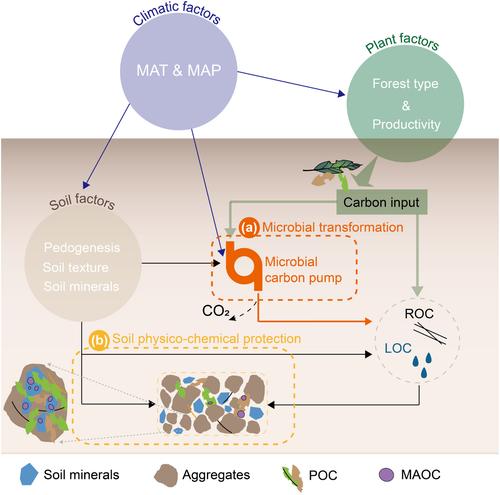当前位置:
X-MOL 学术
›
Glob. Change Biol.
›
论文详情
Our official English website, www.x-mol.net, welcomes your feedback! (Note: you will need to create a separate account there.)
Global pattern of organic carbon pools in forest soils
Global Change Biology ( IF 10.8 ) Pub Date : 2024-06-20 , DOI: 10.1111/gcb.17386 Yuxue Zhang 1, 2 , Xiaowei Guo 3, 4 , Longxue Chen 1 , Yakov Kuzyakov 5, 6, 7, 8 , Ruzhen Wang 1 , Haiyang Zhang 1 , Xingguo Han 1 , Yong Jiang 1 , Osbert Jianxin Sun 1, 2
Global Change Biology ( IF 10.8 ) Pub Date : 2024-06-20 , DOI: 10.1111/gcb.17386 Yuxue Zhang 1, 2 , Xiaowei Guo 3, 4 , Longxue Chen 1 , Yakov Kuzyakov 5, 6, 7, 8 , Ruzhen Wang 1 , Haiyang Zhang 1 , Xingguo Han 1 , Yong Jiang 1 , Osbert Jianxin Sun 1, 2
Affiliation

|
Understanding the mechanisms of soil organic carbon (SOC) sequestration in forests is vital to ecosystem carbon budgeting and helps gain insight in the functioning and sustainable management of world forests. An explicit knowledge of the mechanisms driving global SOC sequestration in forests is still lacking because of the complex interplays between climate, soil, and forest type in influencing SOC pool size and stability. Based on a synthesis of 1179 observations from 292 studies across global forests, we quantified the relative importance of climate, soil property, and forest type on total SOC content and the specific contents of physical (particulate vs. mineral‐associated SOC) and chemical (labile vs. recalcitrant SOC) pools in upper 10 cm mineral soils, as well as SOC stock in the O horizons. The variability in the total SOC content of the mineral soils was better explained by climate (47%–60%) and soil factors (26%–50%) than by NPP (10%–20%). The total SOC content and contents of particulate (POC) and recalcitrant SOC (ROC) of the mineral soils all decreased with increasing mean annual temperature because SOC decomposition overrides the C replenishment under warmer climate. The content of mineral‐associated organic carbon (MAOC) was influenced by temperature, which directly affected microbial activity. Additionally, the presence of clay and iron oxides physically protected SOC by forming MAOC. The SOC stock in the O horizons was larger in the temperate zone and Mediterranean regions than in the boreal and sub/tropical zones. Mixed forests had 64% larger SOC pools than either broadleaf or coniferous forests, because of (i) higher productivity and (ii) litter input from different tree species resulting in diversification of molecular composition of SOC and microbial community. While climate, soil, and forest type jointly determine the formation and stability of SOC, climate predominantly controls the global patterns of SOC pools in forest ecosystems.
中文翻译:

森林土壤有机碳库的全球格局
了解森林中土壤有机碳 (SOC) 固存机制对于生态系统碳预算至关重要,有助于深入了解世界森林的运作和可持续管理。由于气候、土壤和森林类型之间在影响 SOC 库大小和稳定性方面复杂的相互作用,目前仍然缺乏对森林中全球 SOC 固存驱动机制的明确了解。基于对全球森林 292 项研究的 1179 项观察的综合,我们量化了气候、土壤性质和森林类型对总 SOC 含量以及物理(颗粒物与矿物质相关 SOC)和化学(上层 10 厘米矿土中的不稳定与顽固 SOC)池,以及 O 层中的 SOC 储量。矿质土壤总 SOC 含量的变异性可以通过气候(47%–60%)和土壤因素(26%–50%)比 NPP(10%–20%)更好地解释。矿质土壤的总 SOC 含量、颗粒物 (POC) 和顽固性 SOC (ROC) 含量均随年平均气温的升高而降低,因为在温暖气候下 SOC 分解超过了 C 补充。矿物伴生有机碳(MAOC)的含量受温度影响,温度直接影响微生物活性。此外,粘土和铁氧化物的存在通过形成 MAOC 对 SOC 进行物理保护。温带和地中海地区 O 层的 SOC 储量大于北方和亚热带地区。 混合林的 SOC 库比阔叶林或针叶林大 64%,因为 (i) 生产力更高,(ii) 不同树种的凋落物输入导致 SOC 和微生物群落的分子组成多样化。虽然气候、土壤和森林类型共同决定 SOC 的形成和稳定性,但气候主要控制森林生态系统中 SOC 库的全球模式。
更新日期:2024-06-20
中文翻译:

森林土壤有机碳库的全球格局
了解森林中土壤有机碳 (SOC) 固存机制对于生态系统碳预算至关重要,有助于深入了解世界森林的运作和可持续管理。由于气候、土壤和森林类型之间在影响 SOC 库大小和稳定性方面复杂的相互作用,目前仍然缺乏对森林中全球 SOC 固存驱动机制的明确了解。基于对全球森林 292 项研究的 1179 项观察的综合,我们量化了气候、土壤性质和森林类型对总 SOC 含量以及物理(颗粒物与矿物质相关 SOC)和化学(上层 10 厘米矿土中的不稳定与顽固 SOC)池,以及 O 层中的 SOC 储量。矿质土壤总 SOC 含量的变异性可以通过气候(47%–60%)和土壤因素(26%–50%)比 NPP(10%–20%)更好地解释。矿质土壤的总 SOC 含量、颗粒物 (POC) 和顽固性 SOC (ROC) 含量均随年平均气温的升高而降低,因为在温暖气候下 SOC 分解超过了 C 补充。矿物伴生有机碳(MAOC)的含量受温度影响,温度直接影响微生物活性。此外,粘土和铁氧化物的存在通过形成 MAOC 对 SOC 进行物理保护。温带和地中海地区 O 层的 SOC 储量大于北方和亚热带地区。 混合林的 SOC 库比阔叶林或针叶林大 64%,因为 (i) 生产力更高,(ii) 不同树种的凋落物输入导致 SOC 和微生物群落的分子组成多样化。虽然气候、土壤和森林类型共同决定 SOC 的形成和稳定性,但气候主要控制森林生态系统中 SOC 库的全球模式。
















































 京公网安备 11010802027423号
京公网安备 11010802027423号